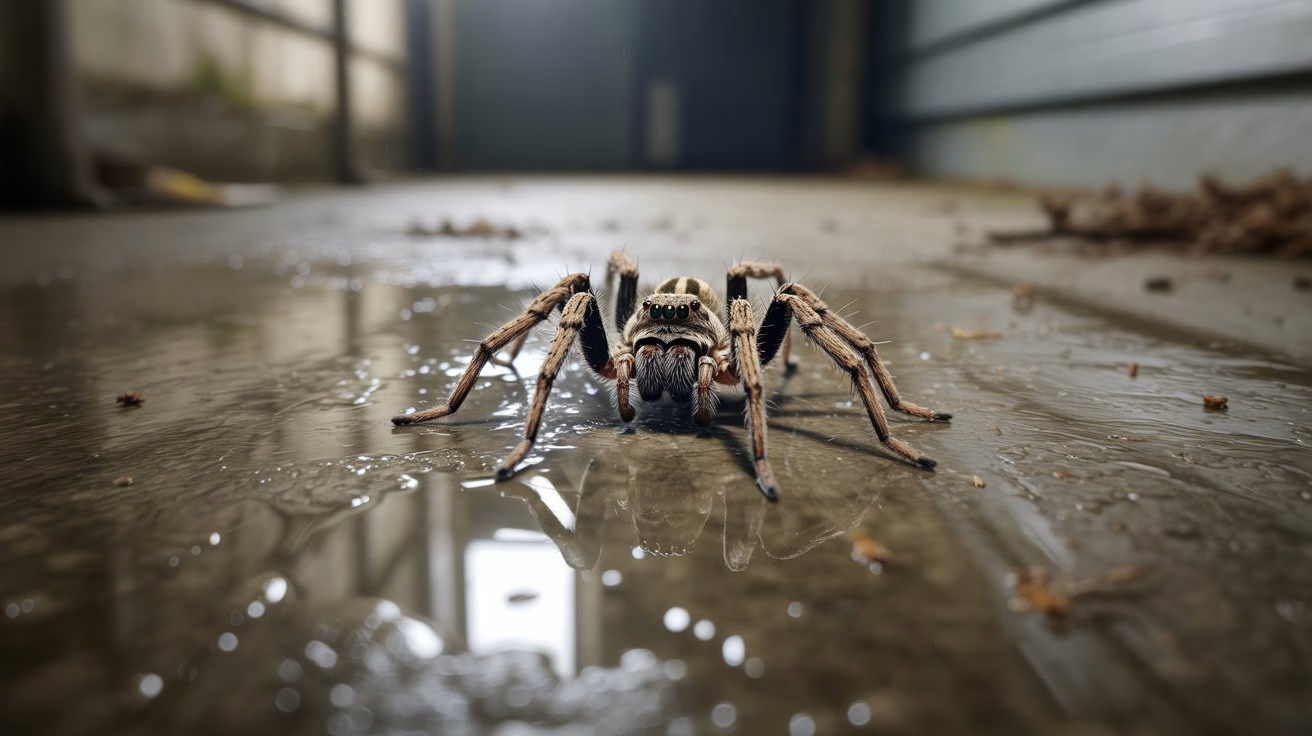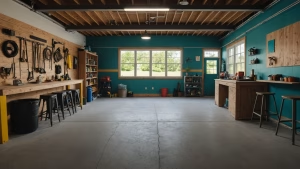This short guide explains why arachnids favor garages and what practical steps you can take right now. Garages are dark, damp, and full of boxes and clutter that attract other bugs and insect activity. Those food sources draw web-builders inside.
Start with easy swaps: replace cardboard with airtight bins and clear clutter so fewer hiding spots remain. Turn off outdoor lights at night to reduce insect traffic and seal gaps with caulk and weather stripping.
Fix leaks and damp spots, then add a plant-based repellent such as EarthKind Stay Away Spiders. One pouch covers about 25 sq ft for roughly 30 days. Combine that with targeted pest control habits and family-safe products from a local store.
Below this intro you’ll find clear, step-by-step ways, product picks, and safety tips for people and pets. Follow the quick wins first, then schedule larger projects on a weekend for lasting results.
Understanding the problem: why spiders choose your garage and shed
Garages and sheds create ideal microhabitats where spiders find food, water, and shelter without much disturbance. These spaces stay dark, hold moisture, and offer stable temperatures that favor web-building and hunting.
Stored cardboard and clutter trap bugs and insects such as silverfish, earwigs, and cockroaches. Those items act as a steady buffet, since spiders eat what crawls through the mess.
Even small leaks or damp patches make humid pockets that attract insect life first, then the predators that follow. Low nighttime traffic in a house garage shed means webs and egg sacs persist longer and populations can rise.
Exterior lights pull flying insect activity toward doors and walls, which raises indoor pest pressure. Clutter gives spiders camouflage and ambush points, so cleaning and organizing cut off both food and hiding spots.
Recognize where a spider builds — corners, ceiling joists, and shelving gaps — and pair those observations with sealing and moisture fixes. Many brands sell repellent-only solutions, but the best ways mix prevention with targeted pest control for lasting results.
Assess the current situation before you act
Begin by calmly surveying your garage so you know where insects and webs collect.
Walk slowly and scan corners, ceiling joists, and behind stored items for web strands, egg sacs, or live spider activity. Check behind appliances and painted surfaces for small signs of movement.
Note moisture: condensation on walls, warped cardboard, and dark stains often mean more insect traffic and higher pest pressure. Mark where clutter is worst and list the types of items that gather dust and bugs.
Close the door during daylight and look for light leaks; gaps are common entry points. Also map airflow and ventilation—stagnant air traps humidity and undoes many pest control steps.
Create a quick checklist: webs found, moisture points, light leaks, exterior lights used at night, cardboard present, stacked fabric or paper. Record cleaning frequency and any brands or products you already use so you don’t repeat ineffective steps.
Decide where to begin: tackle high-traffic corners and shelving first, then move to rafters. Set aside boxes for donation or recycling to open floor space and remove attractant items. This simple assessment frames a practical control plan and saves time when you pick tools and methods for your house garage.
Declutter to cut off food and hiding spots
A tidy storage system cuts off the food chain that brings spiders into your house workspace.
Cardboard boxes attract silverfish, earwigs, and cockroaches, which in turn draw web-builders. Swap cardboard for airtight plastic bins and you reduce those bugs and remove spider food sources.
Sort items by category, then decide what to keep, donate, or recycle. Fewer items mean fewer dark pockets where a spider can nest or where mice and other pest species hide.
Elevate storage on shelves and keep lids closed. Clear under workbenches and corners first — these are prime webbing zones.
Sweep and vacuum after each session to remove egg sacs and debris. Label bins and log contents so you don’t open containers often, which helps maintain control.
If you need more bins or shelving, buy them at a local store and finish the job the same day. Pair decluttering with a light repellent application in high-risk spots to start discouraging harborages. Check brands for family-safe options and follow label directions.
Reduce attractants: lights off at night to keep bugs away
Nighttime lights act like a dinner bell for flying insects, which then draw web-building hunters near your garage.
Turn off interior and exterior lamps after dusk when you can. If lighting is needed, swap in motion-activated, warm-color bulbs; they lure fewer bugs than cool-white options.
Close blinds and fit door sweeps to cut light spill that invites insects from outdoors into gaps. Schedule projects during daylight so natural light does the work and you avoid creating an evening bug beacon.
Place sticky monitors by fixtures to measure how well your changes reduce insects. Combine lighting adjustments with a light surface repellent on thresholds and frames to discourage web placement.
Clean exterior fixtures of dead insects, trim plants near lights, and consider smart timers or a small fan near doors on warm evenings. These steps cut food sources, help pest control efforts, and make your house and garage shed less attractive to spiders.
Seal openings so spiders and insects can’t slip inside
Tiny gaps around doors and vents are common entry points for web-building pests and other insects. Sealing these openings is a high-impact step in any practical pest control plan for a house garage.
Inspect door perimeters, side jambs, and thresholds. Replace weather stripping and add a tight-fitting bottom seal. Use door sweeps and threshold strips for walk-in doors.
Caulk gaps along baseboards, wall penetrations, and where utilities enter. Use expanding foam for large voids around pipes and silicone or acrylic-latex caulk for trim and hairline cracks.
Screen vents and repair torn mesh; even small holes bring buzzing insects that lure a spider. Fit pest-proof gaskets on garage panels and bundle loose cables and hoses so items don’t create tiny anchor points for webs.
After sealing, wipe frames and corners with a mild repellent to discourage immediate re-webbing. Log each sealed spot with dates and re-check after temperature shifts. If you’ve seen mice, add rodent-proof sweeps and hardware cloth on larger openings to cut broader pest and bug pressure.
Fix moisture issues and leaks that invite pests

A steady drip or damp floor gives bugs a stage—and spiders will follow—so stop water where it starts. Pooled water first draws insect prey, then the hunters that feed on them.
Repair dripping hose bibs, utility sinks, and roof seepage quickly. Run a dehumidifier to keep humidity low; dry air disrupts webs and reduces egg sac survival.
Elevate paper items and cardboard off the floor and store fabrics in sealed bins. Insulate cold water lines to prevent sweating that wets shelves and stored items.
Improve gutter and downspout drainage so water does not pool near the foundation of your house or garage. Add fans or passive vents to cut condensation on windows and cold surfaces.
After repairs, wipe baseboards and apply a light repellent along moist zones. Check for mice droppings near water sources—rodents seek moisture and worsen pest control problems.
Keep a simple moisture log and reassess monthly, especially after heavy rain. Small, regular checks prevent larger repairs and help keep spiders and other pest activity from returning.
How to keep spiders out of garage
A simple, repeatable routine using botanical products and small repairs gives fast results.
Start with a plant-based spider repellent such as EarthKind Stay Away Spiders. Place one pouch per 25 sq ft; each lasts about 30 days. Use pouches in corners, on shelving, and near doors where activity is highest.
Pair that repellent with decluttering, lights-off habits at night, sealing gaps, and fixing leaks. These steps stop the insects spiders eat and remove the hiding spots that attract new arrivals.
Fast wins include removing cardboard, vacuuming webs, and tidying corners to get rid immediate harborages. Buy refill pouches and similar products at a local store and stick with trusted brands you can restock easily.
Track results weekly: note fewer webs and sightings. If activity continues, expand coverage or add perimeter treatments. Keep safety top of mind—apply labels as directed and avoid overuse in small house spaces.
Natural, plant-based ways to repel spiders
Plant-based scents can make your workspace less appealing to web-builders. Choose a plant-based spider repellent that lists essential oils and clear plant-based ingredients on the label.
Peppermint oil sachets or a light spray work well. Refresh peppermint oil often so the scent stays strong enough to act as a repellent.
EarthKind Stay Away Spiders uses essential oils; place one pouch per 25 sq ft and replace every 30 days for steady coverage. The scent is pleasant for people and, in user reports, pet safe around cats when pouches are out of reach.
Test a small area first and keep pouches on high shelves or inside bins where curious pets cannot access items. Stock up at a nearby store or order extra products so you maintain a refill cadence through busy seasons.
Combine these natural choices with sealing gaps and decluttering for the best results. Pick brands that list all plant-based ingredients and note which items last longest in your garage shed climate.

Sticky traps and web removal for ongoing control
Use low-profile sticky traps along baseboards, behind storage, and near door thresholds to monitor activity and intercept crawling pests. Place traps where items sit long-term so you learn which zones need the most work.
Remove webbing weekly with an extendable duster or a vacuum crevice tool. Clean corners, ceiling joists, lights, and shelving gaps first; immediate web removal lowers egg sac survival and discourages quick re-webbing.
Log trap counts by location and date. Rising catches in one spot often point to an entry gap, a moisture pocket, or nearby insect activity you can fix with sealing or lighting tweaks.
Swap or rotate traps monthly or when dusty. Pair light repellent applications in corners with web removal to reduce re-establishment. Keep sticky surfaces away from children and pets; use cardboard sleeves if needed.
Date each trap so you can link results with other changes in your house. If traps catch mostly insects, focus on exterior lighting and sealing. If they catch more spiders, tighten indoor controls in those zones.
Perimeter defense: sprays and treatments that keep spiders away
A strong exterior barrier is one of the fastest ways to cut insect traffic before it reaches your doors.
Treat the foundation, door frames, and window trim with a light perimeter band. Products sold as home defense, such as Ortho Home Defense and similar brands, work well when applied per label directions. Match product choice with the surface and the pest you want to control.
Permethrin concentrates, available at a local supply store like Tractor Supply, can be mixed in a pump garden sprayer. Follow the dilution instructions for the target insect and surface. Apply on dry days and let treated areas dry fully before re-entry.
For sensitive users, start with peppermint oil or low-odor repellent sprays outdoors and expand only if needed. Never apply permethrin to cats; keep children and pets away during application and drying.
Keep a dedicated sprayer labeled for perimeter work and restock at a nearby store. Reapply every 4–8 weeks during peak seasons. Combine this exterior band with interior monitoring—fewer webs and lower trap counts show the barrier is working.
Choosing products: spider killer spray, spider repellent, and brands
Deciding which product to buy comes down to where you’ll apply it and how fast you need results.
For immediate control, a spider killer spray or killer spray gives quick knockdown. Use trigger sprays for indoor spots and keep a labeled sprayer for exterior work.
For ongoing deterrence, pick a long‑lasting repellent. EarthKind Stay Away Spiders uses essential oils and works as a pouch placed one per 25 sq ft for up to 30 days.
Plant-based options list plant-based ingredients and are often pet safe when used as directed. Peppermint oil sprays or pouches are low-odor and need refreshing every 2–4 weeks depending on airflow.
For exterior bands, brands like Ortho Home Defense and other ortho home lines are common. Permethrin concentrates are available at Tractor Supply for perimeter mixes, but never use permethrin on cats.
Buy from a nearby store for fast restocks or a farm supply for concentrates. Compare products by residual life, scent, indoor/outdoor suitability, and label rules. Track what you use and where so you can judge which brands and products work best in your climate.
Safe for people and pets: best practices inside a house garage
Protecting people and pets starts with product choices that cut risk while keeping effectiveness high. Pick methods that work quickly and are labeled pet safe for indoor use in a house garage.
Use a plant-based repellent or pouches where pets cannot reach. A customer reported EarthKind’s plant-based repellent caused no issues for their cats and cleared spiders within two days. Keep liquid concentrates sealed and stored in labeled bins away from food.
Avoid fogging in tight spaces; spot treatments and targeted spider repellent applications are safer and often just as effective. Ventilate the area during and after application for comfort and safety.
For indoors outdoors movement, let sprays dry fully before re-entry or parking vehicles. Record each product, application date, and any pet reactions so you can choose pet safe options next time.
Final tip: combine these safe steps with decluttering, sealing, and moisture fixes. That lowers overall product use and keeps your home and house garage friendlier for pets and people alike.

Target the dangerous ones: black widow and brown recluse precautions
Recognizing key markings and behavior helps you respond safely when a risky find appears. Learn the shiny hourglass shape of a black widow and the violin mark of a brown recluse so identification is quick and calm.
Always wear gloves and long sleeves before moving stored items or reaching into dark corners. Don’t shake cardboard; slide boxes into light and inspect them slowly to avoid surprise contact with a spider.
Place sticky monitors near low shelves and under benches to detect activity early. If you confirm a black widow or brown recluse, escalate pest control steps: seal gaps, treat the exterior band, and place repellent pouches in high-risk zones per label.
Store shoes, gloves, and loose items in sealed bins so critters cannot shelter inside. Keep a regular web removal routine in seldom-used corners and review problem areas quarterly.
If bitten or if you suspect either species, seek prompt medical care and call a professional for a full inspection. Teach family members the distinguishing marks and a calm response plan so everyone stays safe.
Maintenance plan: keep spiders away season after season
A monthly maintenance plan makes seasonal spikes easy to manage and prevents gaps in protection. Small, regular steps keep stored items dry and reduce food sources that draw spiders and their prey.
Create a simple checklist: declutter hotspots, vacuum webs, check door seals, and refresh repellent placements on schedule. For botanical pouches, replace every 30 days and use one pouch per 25 sq ft for steady coverage.
Use a subscribe save reminder or calendar alert so you restock pouches and sprays before they run out. Rotate peppermint oil sachets or pouches every 2–4 weeks during peak summer and fall seasons.
Keep sticky traps dated and replace them monthly; chart catches to reveal patterns and guide control efforts. Do a seasonal seal check—temperature swings can open gaps that invite insects and mice back inside.
Store products and labels together, note brand and placement date, and tie refills to routine tasks like filter changes. A quick 10-minute tidy each week returns items to bins and keeps corners clear so new web anchors don’t form.
Restock from your preferred store ahead of peak months and use small wins consistently. Over time, this simple plan reduces sightings, limits re-infestation, and makes long-term house garage upkeep much easier.
Troubleshooting a persistent infestation
Long-term spider trouble sometimes starts with one overlooked delivery or parked trailer. A homeowner reported years of activity after storing a trailer that carried nests and egg sacs.
If you can’t get rid persistent activity, inspect for a single-source event like used furniture, tarps, or that trailer. Double down on seal openings around doors, utilities, and garage corners where gaps hide egg sacs.
Expand your exterior perimeter program. A foundation band with permethrin in a pump sprayer helped some users cut insects and pest pressure. Never use permethrin on cats, and follow label directions or choose an ortho home defense or home defense labeled product for safe application.
Alternate product types: rotate natural interior repellents with an exterior residual. Increase web removal to every few days in hotspots; sustained pressure and egg sac removal will rid spiders over time.
If trap counts remain high, identify the insect type most common in traps and target that prey. Reassess clutter under shelves or tarps—hidden items and mice can keep pest pressure high.
Keep records of brands used, dates, and results. Source refills and tools at a nearby store so you can escalate quickly. If DIY steps stall, hire a pro for a full inspection and a tailored pest control plan.
Conclusion
Layering small fixes and reliable products makes pest control manageable and long-lasting.
Stick with simple habits: declutter, seal gaps, fix moisture, and refresh your repellent on schedule. These steps keep insects low and reduce spider sightings in a house or garage.
Choose brands and products you can restock at a nearby store. Log what works for your items and climate. Consider a subscribe save reminder for monthly pouch or spray replacements so coverage never lapses.
If activity persists, step up exterior control and re-check seals. With steady upkeep and smart choices, your home stays neater and less welcoming to spiders and the pests they follow.













